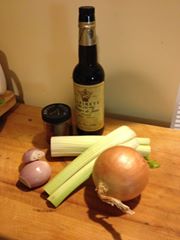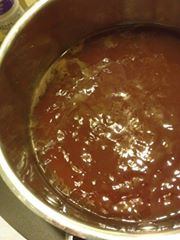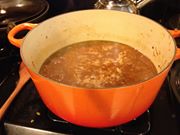This piece was originally published as a three-part note on Facebook, March 21-26, 2014. Facebook’s “Memories” feature helpfully reminded me of the anniversary in 2017, prompting me to post it here.
Part One
Where does this tale begin? The struggle with the Terpenoids only lasted a day, but the roots of the story go much deeper. I can’t tell every tale starting with the universe that came before it, though. It would help if you knew me, a little—that I approach cooking from sacred and social and scientific perspectives, and that for me it’s only partly about eating, and feeding others. It’s also about taking pleasure in technique, and honoring what has come before: the struggles of various collections of molecules to find joy in the processes of survival and creation.
So, without heading all the way back to the cookpots of the cosmos, I guess this starts on March 2nd, 2014, with the “short ribs and rainbow carrots” incident. Or maybe around Christmas, with the bone broth.
I don’t follow a “lifestyle diet” or “way of eating” (which is sometimes abbreviated by online discussants as “WOE”), like Paleo or GAPS or Feingold. I was on the Zone for a while, years ago, and started to be evangelical about it, but there was, in the long run, too much precision to maintain (for me). For the past few months I’ve been trying to address some deeper stress-related issues, and I’m following doctor’s orders which include eating quite a lot of protein. I’ve been reading up on ways to get more protein, and several paths of inquiry in that direction featured bone broth.
The Grandmothers perked up at that phrase. (The Grandmothers are a collection of ancestral entities who hang around the back of my brain making helpful suggestions, like “Maybe you should eat more hazelnuts,” and “You know what’s good for you? Mushrooms.” and “What do you mean, you don’t have any duck fat in the house? It’s October! Do you want us all to starve??”, except they mostly speak French.) They liked the sound of bone broth, and they had been pleased with the Christmas sauce this year which was based on an oxtail stock. I’ve been making a slow-cooker full of broth every couple of weeks since Christmas, experimenting with cuts and combinations. The best flavor so far was from a combination of beef short ribs, chicken wings, onion, celeriac peel (I was roasting the celeriac for another dish), quite a lot of parsley, and rainbow carrots—a thing I didn’t know existed, but which presented themselves all proud at My Organic Market a few weeks back.

I wanted oxtail, but couldn’t find any. Short ribs brown gorgeously, and the meat has many textures all in one bite (which I like), and their bones are tasty, but they don’t have a lot of gelatin. I bought the chicken wings hoping for a better gelatin balance (wings = many joints in small space, and joints usually carry gelatin), but it didn’t work out. The flavor of the broth is intense and exactly what I want, but the mouthfeel is watery. I want more density on the palate—slippery, like silk charmeuse. There should be hints of unctuousness.
I’ve been holding that perfectly-flavored broth, re-boiling it every few days to concentrate it more and keep it wholesome. I bought some oxtails on Sunday, intending to make a high-gelatin batch to add to the perfect-flavor broth. At the same time, I bought a bag of normal carrots. Unassuming, uniformly orange, organic carrots. Little did I know they hid a terrible secret. I was about to be overwhelmed by Terpenoids.
Part Two
The carrots were the problem.
I started the high-gelatin stock on Wednesday—well-browned oxtail, carrots (not browned, and un-tasted, alas, alas!), garlic, peppercorns, a little salt, filtered water to cover, slow cooker on low. When I got home on Thursday, I could smell it. Something wasn’t right. There was a hint of phenol in the aroma, and a note of hot potting soil. It was distressing. (I know what hot potting soil smells like because sometimes I sterilize it in the oven for potting particularly fragile or mold-vulnerable plants.)
I’m sure you are familiar with Bad Carrots—the ones that taste like soap and aluminum. The charming World Carrot Museum explains that these flavors are caused by an overbalance of the proportion of terpenoids to sugars in a carrot’s flavor profile. Genetics, terroir (all the climate and soil/geology and water characteristics of where the carrots grew), and storage (e.g., too long in cold storage, or close to apples) can all promote a high proportion of terpenoids. My sister Michelle says that the Holyoke Hadley Silt Loam terroir in Massachusetts where she lives, while famously fertile and good for many things, grows disgusting carrots does not always produce delicious carrots [edited in 2018, when Michelle softened a previous opinion].
The stock was terrible. Spit-it-out awful, with a lingering aftertaste of burnt soap. The oxtail joints had absorbed (or at least been coated in) that awfulness as well. I was briefly despondent and posted for help on Facebook. Useful suggestions flooded in. I was grateful, and calm, and I made a plan: (1) Physical Removal, (2) Re-Balancing, and (3) Layering More Flavors on Top. (This was the approach championed by Jill, Omie, and Seth, who have my thanks.)
Don’t bother Googling this topic yourself. Mitigating the soapy taste of Bad Carrots is not something that a lot of people have discussed online in any detail (beyond “Carrots are sometimes soapy-tasting! Gross!”). Almost all of the easily-found references on “neutralize terpenoids” and similar searches find resources intended for professional cannabis growers, for whom terpenoids are apparently desirable. The one useful thing Google could find for me: Terpenoids are lipid-soluble.
As such, presumably the terpenoid compounds would be largely held in the grease layer of the stock, in the particles of fond, and in the oxtail—particularly the fatty layer on the outsides of each joint. I scooped out all the solids from the stock with a slotted spoon, discarding the offending carrots. I strained the stock through a cheesecloth-lined sieve into a glass bowl, and set it in the fridge to settle. I rinsed the oxtail joints, poured a little olive oil over them, and put them in the refrigerator as well. I also put some Aleppo pepper (a rich, medium-warmth, flaked red pepper from Penzeys) in some sherry vinegar to infuse. All this happened on Thursday evening.

On Friday, I poked around the Internet looking for recipes that would (a) use the oxtail and stock, and (b) add several other layers of flavor. I started with a recipe for Oaxacan black bean soup (no idea if it’s authentically Oaxacan; it’s from Cooks.com, which anyone can contribute to). I’m not an orthodox recipe-follower, but the heat and earthy profile of the spices in this soup seemed like a good direction.
(1) Physical Removal: I skimmed the solidified fat from the chilled stock. I poured the skimmed stock from its bowl into a saucepan. In so doing, I noticed a thick layer of silt at the bottom of the bowl—fine particulates that hadn’t been caught by the sieve. I stopped mid-transfer and tasted that layer. Horrible. Massive terpenoid concentration. I removed as much of the silt as I could from what was in the saucepan.

I also tasted a tiny bit of the skimmed fat—also horrible, validating the “lipid soluble” approach. I poured boiling water over the oxtail joints, and then poured off the water + the olive oil that floated to the top (carrying terpenoids with it). The oxtail meat still carried hints of terpenoid, but much milder (tasting “mostly like meat” instead of “mostly like Band-Aids and copper”). Then I carefully tasted the clear, nicely gelled stock: Yes, the terpenoids were still there and still intrusive, but dramatically reduced. There was hope. More work would not necessarily be in vain.
(2) Re-Balancing: It’s not that the terpenoid flavors had to be annihilated. There are terpenoids in all carrots, and thus all stock (well, stock that I make, because I always use carrots). It’s just that these were so badly overbalanced. I wanted to tip the scales, re-building the sweetness that should have been the carrots’ primary contribution.
I sliced an onion and two shallots and set them to caramelize with a little bit of duck fat. (An article from Slate about how long it takes to caramelize onions was a comfort—and since my initial writing, it has become an amazing example of the limitations of Google Search.) After ten minutes I added a dash of agave nectar and a half-teaspoon of salt.

After another 20 minutes, I added 2 cups of very finely sliced celery heart. Fifteen minutes later, when everything looked and smelled well-caramelized, I added the stock. I simmered it for ten minutes and tasted it very carefully. Success. The “Oh horrible, horrible” had been balanced out to “Nice hints of earthiness”.
(3) Layering More Flavors on Top: When the onions went in the pan, I shredded the oxtail meat and set it to marinate with the Aleppo-pepper-infused sherry vinegar, plus some cumin, coriander, and dried orange peel. When I tasted the re-balanced stock, I also tasted the marinated oxtail. Success here as well: Bright top-notes, good meatiness, and a supporting earthy note—the carrot-terpenoids playing nicely with the cumin. The meat went into the broth along with a can of refried black beans.

What is on my stove now is quite a respectable soup, which I’m looking forward to eating, maybe with some pan-brown queso blanco on top, a squeeze of lime, and some of my brother-out-law Matthew’s homemade hot sauce.
Terpenoids are conquerable. It takes work, but in this case was entirely worthwhile, because (a) Victory for Science, and (b) the Grandmothers are pleased with me for not wasting the oxtail. There’s only one on a whole cow, after all, and with spring coming on it’s time to switch to lamb.
Part Three
Endgame.
Total victory.
Black bean and oxtail soup: Caramelized onion, shallot, celery, cumin, coriander, orange peel, Aleppo pepper, sherry vinegar, homemade oxtail stock (terpenoids removed).

Garnish: Avocado, lime, Serrano pepper, shallot, and crisp-fried farmstead mozzarella (which is half Jersey cow milk and half goat’s milk and quite wonderful, from Keswick Creamery via the Takoma Park Farmer’s Market).
We’ve moved far beyond “respectable salvage / dinner’s not totally ruined” to “I really hope I can duplicate this without going through the same degree of hassle next time.”
If I had a bistro, I’d put this on the menu.